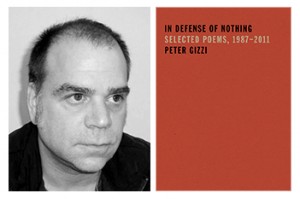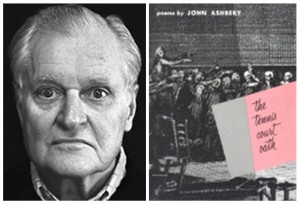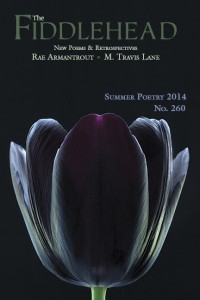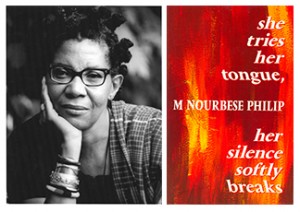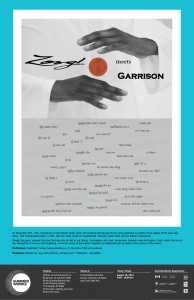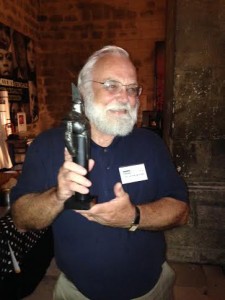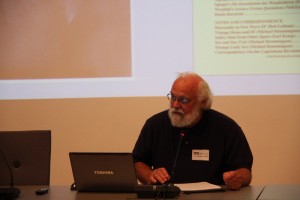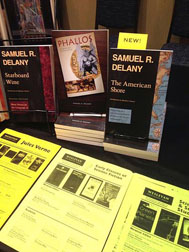This week’s Throwback Thursday selection is Kenneth Goldsmith’s “’Page One’ from The Day,” published in Wesleyan’s anthology, American Poets in the 21st Century: The New Poetics. The poem is from Goldsmiths book Day. Listen to Goldsmith read his poem here, at the book’s companion website.

.
“Page One” from Day
“All the News
That’s Fit to Print”
The New York Times
Late Edition
New York: Today, mainly sunny and noticeably less humid, high 79. Tonight, clear, low 62. Tomorrow, sunny and cool, high 76. Yesterday, high 86, low 73. Weather map is on Page D8.
VOL. CL. . . No. 51,873
Copyright © 2001 The New York Times
NEW YORK, TUESDAY, SEPTEMBER 11, 2001
$1 beyond the greater New York metropolitan area.
75 CENTS
Photographs, clockwise from top left, by Librado Romero, Ruby Washington, Ruth Fremson and James Estrin / The New York Times
THE HOME STRETCH On the last day of campaigning, the mayoral candidates scoured the city for votes. Clockwise from top Peter F. Vallone, Alan G. Hevesi and Mark Green talked with voters in Brooklyn and Manhattan. The polls are open from 6 a.m. to 9 p.m. Page B1
Nuclear Booty:
More Smugglers
Use Asia Route
By DOUGLAS FRANTZ
ISTANBUL, Sept. 10 – The police in Batumi, a Black Sea port in Georgia, heard a rumor in July that someone wanted to sell several pounds of high-grade uranium for $100,000. The most tantalizing aspect of the tip was that one of the sellers was reportedly a Georgia Army officer.
All sorts of scoundrels have tried nuclear smuggling in recent years. Many are amateurs; most of what they try to peddle proves useless for making bombs.
But the possible involvement of an army officer gave the Batumi case a measure of deadly seriousness, beyond its status as another example of how the smuggling of nuclear material has shifted to Central Asia.
On the morning of July 20, the local antiterrorist squad burst into a small hotel room near the port, just outside the Turkish border. They arrested four men, including an army captain named Shota Geladze.
On the floor of the room, in a glass jar wrapped in plastic, sat nearly four pounds of enriched uranium 235, according to Revaz Chantladze, one of the police officers. The quantity was less than is usually required for a small atomic bomb.
Subsequent analysis yielded differing opinions. A Western diplomat
Continued on Page A10
City Voters Have Heard It All
As Campaign Din Nears End
By JIM DWYER
The first time the phone rang, Victoria Ehigiator was elbow deep in a sink of soapy dishes. She dried her hands and picked up the phone. It was Al Sharpton on the line, calling about the primary election. He said his piece, and she went back to the dishes. A few minutes later, the phone rang again, and she lifted herself from the bubbles once more.
That time it was Fernando Ferrer. And then it was Gloria Davis. Followed by Adolfo Carrión.
As one digitized caller after another dropped into her home, thanks to new technology that can swamp the telephones in a ZIP code or an entire city with the actual voice of, say, Ed Koch, urging a vote for Peter Vallone, Ms. Ehigiator started to suspect that very few people in New York were not running for something – whether it was mayor, comptroller, public advocate, borough president or City Council.
And as for those few who weren’t candidates, they all seemed to be calling her about those who were.
Had Bill Bradley actually phoned her about Herb Berman? And who was Herb Berman, anyway? (Psst: he’s a council member running for comptroller.)
“There was another guy – his name starts with S,” said Ms. Ehiglator, of Morrisania in the Bronx, offering no other clues. “I’m trying to do the Sunday dishes but I never got off the phone with all these animated
voice messages. It was a real fiesta of phone calls.”
Today is the end of the busiest primary campaign around here that anyone can remember, and the candidates are ganging up on the small fraction of the electorate that customarily decides such races. From the high cliffs of northern Manhattan to the ocean foam at Rockaway Beach, New Yorkers report they are coping by slamming down the phone faster, throwing out the mail sooner,
Continued on Page B5
a Nation of Early Risers,
Morning TV Is a Hot Market
By BILL CARTER
How much morning television can one nation watch?
Ever since the owlish Dave Garroway ambled through the “Today” program on NBC starting in 1952, sometimes accompanied by a chimpanzee, television screens have greeted awakening Americans with the combination of hard news, feature reports and soft celebrity interviews that has come to be known as the morning news program.
But the competition for bleary eyes has grown more intense as media conglomerates have awakened to
the idea that changing lives, heightened interest from advertisers and other factors have made the morning one of the few areas of growth in the television business.
That trend was underscored last week when CNN raided its rival all-news cable network, Fox News, and took the anchor Paula Zahn for a new morning program it will begin next spring from inside the Time & Life Building at 50th Street on the Avenue of the Americas in Midtown Manhattan.
According to Fox executives, reading from the offer sheet they said CNN gave to Ms. Zahn, CNN agreed to triple her salary, bringing it over the $2 million mark.
The figure would be by far the most money CNN has ever paid for an anchor, far more than double what CNN agreed to pay to Aaron Brown, the anchor it has brought in from ABC to lead a prime-time newscast.
The raid and Fox’s response — a lawsuit — represent the latest nasty interchange between Fox News and CNN, and serve as a proxy for a larger corporate battle between
Continued on Page C16
NEWS SUMMARY A2
Arts E1-10
Business Day C1-16
Editorial, Op-Ed A22-23
International A3-15
Metro B17
National A16-21
Science Times F1-12
Sports Tuesday D1-8
World Business W1-8
Fashion B7-8
Fashion B7-8
Health/Fitness F5-12
Obituaries C17
Weather D8
Classified Ads F9-11
Auto Exchange D4
Updated news: www.nytlmes.com
School Dress Codes vs. a Sea of Bare Flesh
By KATE ZERNIKE
MILLBIJRN, N.J., Sept. 7 — In the tumult of bare skin that is the hallway of Millburn High School, Michele Pitts is the Enforcer.
“Hon, put the sweater on,” she barks at a pair of bare shoulders.
“Lose those flip-flops,” to a pair of bare legs.
One student waves her off as Mrs. Pitts crosses her arms in a “Cover that cleavage” sign. “You talked to me already,” the girl insists, then promises, “Tomorrow!” as she disappears around a corner.
Baseball caps, a taboo of yesteryear, pass by unchallenged, having slipped in severity on a list of offenses that now include exposed bellies, backs and thighs. For Mrs. Pitts, the assistant principal, there is simply too much skin to cover.
With Britney Spears and CosmoGirl setting the fashion trends, shirts and skirts are inching up, pants are slipping down, and schools across the country are finding themselves forced to tighten their dress codes and police their hallways.
This fall, New York State is requiring all public school districts to adopt dress codes as part of a larger code of conduct. In North Carolina, the bill that allowed schools to post the Ten Commandments also required them to institute dress codes.
The days when torn jeans tested the limits are now a fond memory. Today, schools feel the need to remind students that see-through clothing is not appropriate. (The Liverpool Central School District, near Syracuse, learned this when two high school girls showed up on Halloween dressed in Saran Wrap. Only one appeared to be wearing underwear.)
In the new dress codes, spaghetti straps are forbidden (straps must be no less than an inch and a half
Don Standing
for The Now York Times
The dress code
at Millburn High
School aims to
raise standards and self-respect.
It frowns on low
necklines, bared
shoulders, flip-
flops and spa-
ghetti straps.
wide), as is clothing that “bares the private parts”; fishnet stockings and shirts; T-shirts with lewd messages; flip-flops or other clothing more suited to the beach; and skirts or shorts above mid-thigh. Boys cannot wear tank tops or
Continued on Page B7
INSIDE
Mrs. Dole to Run for Senate
Elizabeth Dole plans to announce that she will run in 2002 for the Senate seat being vacated by Jesse Helms of North Carolina. PAGE A16
Afghan Rebel’s Fate Unclear
A day after a bombing aimed at the leader of the opposition to the Taliban, there were conflicting reports as to whether he survived. PAGE A15
Morgan Stanley Bias Suit
The Equal Employment Opportunity Commission filed a sex-discrimination suit against Morgan Stanley Dean Witter. BUSINESS DAY, PAGE C1
FOR HOME DELIVERY CALL 1-800-NYTIMES
0 354613937201
Giants Fail in Opener
The Giants allowed touchdowns in every quarter as the host Denver Broncos rolled to a 31-20 victory.
SPORTSTUESDAY, PAGE D1
Debate Over Shark Attacks
Commercial fishermen are at odds with scientists over the reason for a spate of highly publicized shark attacks. SCIENCE TIMES, PAGE F1
Scientists Urge
Bigger Supply
Of Stem Cells
Report Backs Cloning
to Create New Lines
By SHERYL GAY STOLBERG
WASHINGTON, Sept. 10 – A panel of scientific experts has concluded that new colonies, or lines, of human embryonic stem cells will be necessary if the science is to fulfill its potential, a finding that is likely to inflame the political debate over President Bush’s decision to restrict federally financed research to the 64 stem cell lines that are already known to exist.
In a 59-page report that examines the state of human stem cell science, the panel also endorsed cloning technology to create new stem cells that could be used to treat patients. Mr. Bush strongly opposes human cloning for any reason, and the House of Representatives voted in July to outlaw any type of cloning, whether for reproduction or research.
The report by the National Academy of Sciences, perhaps the nation’s most eminent organization of scientists, is scheduled to be made public on Tuesday morning at a news conference in Washington. It does not address Mr. Bush’s policy directly, though it strongly supports federal financing for stem cell research.
“High quality, publicly funded research is the wellspring of medical breakthroughs,” said the report, a copy of which was provided to The New York Times by Congressional supporters of stem cell research. It added that federal financing, and the government oversight that comes with it, “offers the most efficient and responsible means of fulfilling the promise of stem cells to meet the need for regenerative medical therapies.”
Though the academy often issues its reports in response to requests from the government, it embarked on this study on its own earlier this year. The study was not an exhaustive review of the scientific literature in stem cells, but was rather intended to examine the prospects for the on this study on its own earlier this year. The study was not an exhaustive review of the scientific literature in stem cells, but was rather intended to examine the prospects for the research and to make policy recommendations. The report was written
Continued on Page A18
Strict Arsenic Limit Sought
Strict standards for arsenic in drinking water, suspended by the Bush administration, were justified, experts have concluded. Page A20.
KEY LEADERS TALK
OF POSSIBLE DEALS
TO REVIVE ECONOMY
BUSH IS UNDER PRESSURE
Lott Open to More Tax Cuts –
Democrat Sees Temporary
Dip Into Social Security
By ALISON MITCHELL
and RICHARD W. STEVENSON
WASHINGTON, Sept. 10 – Key figures in both parties responded to the darkening economic outlook today by exploring possible compromises on additional tax cuts, and the Democratic chairman of the Senate Budget Committee suggested that such a deal could involve the politically perilous step of tapping temporarily into the Social Security surplus.
Pressure mounted on President Bush to drop his cautious approach to dealing with the weakening economy, much of it from within his own party. Republicans are voicing growing concern that the White House has underestimated public unease about the economy and the threat it poses to members of Congress up for re-election next year.
Confronted with polls showing that support for Republicans was eroding even before the government reported on Friday that the unemployment rate had surged, nervous Republicans moved on a variety of fronts.
In the House, Republican leaders agreed tonight to take up legislation in committee on Tuesday that would require automatic spending cuts if any Social Security money was spent on other government programs in the current fiscal year.
After accounting for the slowing economy and the tax cut signed into law by Mr. Bush in June, the Congressional Budget Office projected last month that the government would spend $9 billion of Social Security receipts in the fiscal year that ends Sept. 30. Both parties now expect that figure to be higher.
The White House sent a memorandum to all cabinet agencies today asking them to look for possible budget cuts as the administration develops tax and spending proposals for its next budget.
In the Senate, Trent Lott of Mississippi, the minority leader, said he was open to an idea floated by Democrats for a tax cut for workers who had not qualified for the current rebate. Workers who do not make enough money to pay federal income taxes but who still pay the payroll taxes that finance Social Security and Medicare will not receive rebate checks this year.
Mr. Lott said he would like to see
Continued on Page A20
Traced on Internet,
Teacher Is Charged
In ’71 Jet Hijacking
By C.J. CHIVERS
Thirty years after a black-power revolutionary hijacked a jetliner from Ontario to Cuba and disappeared, Canadian and federal authorities matched the fingerprints he left on a can of ginger ale in the airplane with those of a teacher in Westchester County and charged the teacher with the crime yesterday.
The teacher, Patrick Dolan Critton, 54, of Mount Vernon, N.Y., was charged with kidnapping, armed robbery and extortion in United States District Court in Manhattan. He is facing extradition to Canada, where a detective had tracked him down through a simple Internet search.
The authorities said that Mr. Critton, a fugitive for 30 years, had been hiding in plain sight for the last seven years, working as a schoolteacher, using his real name, raising two sons and mentoring other children. Even one of the police officers who arrested him said he had the appearance and demeanor of a gentleman.
But as a young man, the authorities said, Patrick Dolan Critton was a revolutionary with a taste for the most daring of crimes.
By 1971, when he was 24, he was wanted by the New York City police on charges that he participated in a bank robbery that led to a frantic gun battle with the police, and that he had worked in a covert explosives factory on the Lower East Side, where the police said he made pipe bombs with other members of a black liberation group, the Republic
Continued on Page B6
SPEND “AN EVENING WITH JOHN WATERS” this Saturday and see the director’s cut of “Female Trouble.” For tickets to this TimesTalks event at the Gay Life Expo, call (212) 352-3535 – ADVT
From the Author:
"I am spending my 39th year practicing uncreativity. On Friday, September 1, 2000, I began retyping the day's NEW YORK TIMES word for word, letter for letter, from the upper left hand corner to the lower right hand corner, page by page." With these words, Kenneth Goldsmith embarked upon a project which he termed "uncreative writing", that is: uncreativity as a constraint-based process; uncreativity as a creative practice. By typing page upon page, making no distinction between article, editorial and advertisement, disregarding all typographic and graphical treatments, Goldsmith levels the daily newspaper. DAY is a monument to the ephemeral, comprised of yesterday's news, a fleeting moment concretized, captured, then reframed into the discourse of literature. "When I reach 40, I hope to have cleansed myself of all creativity."





